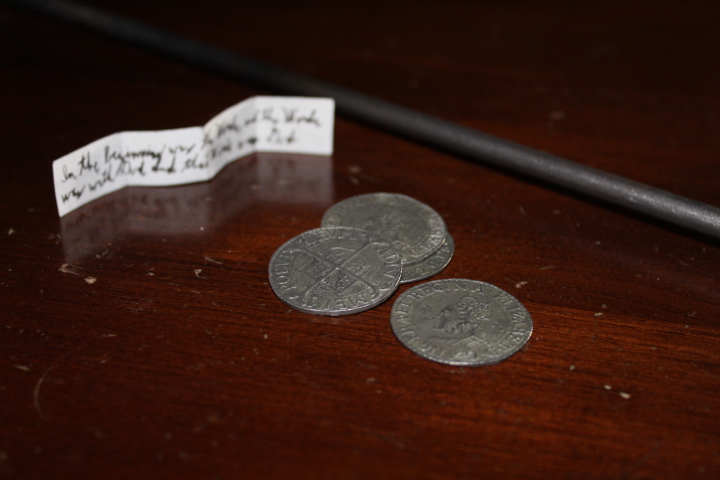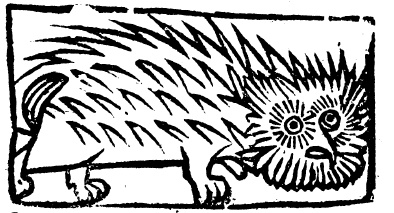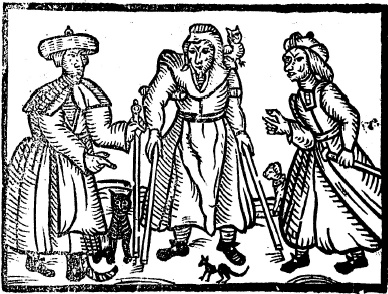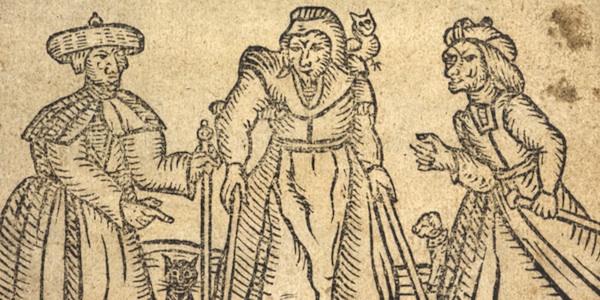Although there were certainly some skeptics , early modern English subjects at all levels of society feared witches. Where there is fear, people seek certainty. As a result the English utilized a number of defense measures against this perceived threat. Such defenses existed along a spectrum, ranging from prayers for divine intervention to folk remedies. Only a few of these measures were officially sanctioned by state and religious authorities, and many were not written down but simply passed around by word of mouth. Nevertheless, some of the countermeasures used by early modern English subjects survived into the modern day for us to examine.
It will be helpful, first, to define what was meant by the word “witch” in early modern England. A witch was not simply someone who practiced magic (although magicians of all sorts were typically suspect at the very least), but rather a person who could work “wonders” through a “covenant with Satan.”[1] In exchange for the witch’s soul and loyalty, it was believed that the Devil, either himself or through a spirit hired out as the witch’s “familiar,” would do special favors for his witches, such as uncovering hidden riches or exacting retribution on their enemies.[2] Such retribution might take the form of sickness, death, demonic possession, or even natural disasters brought down upon the victim.[3]

Even the strictest and most educated English Protestants acknowledged witchcraft and demonic assault as real and present threats. However, official doctrine held that these threats were permitted by God, either to test the righteous or punish sinners.[4] As such, those suffering at the hands of witches were admonished not to seek out charms or folk cures but to pray, repent, and humble themselves before God in hopes of deliverance by divine grace.[5]
Unsurprisingly, this advice left many unsatisfied. For the rustic and common sort there were many folk remedies available, but to the middling and upper classes such measures smacked of superstition. Following the Protestant maxim of sola scriptura (scripture alone), these English subjects used the Bible to protect themselves against witchcraft. Paper amulets with verses of scripture, especially the first verse of the Gospel of John (“In the beginning was the Worde, and the Worde was with God and that Worde was God” in the Geneva Bible), were worn in the belief that they would shield the wearer from supernatural attack.[6] If that failed, reading the Bible aloud was considered a surefire way to drive off a witch’s spiritual assault.[7] By the same token, it was a common belief that a witch could be known by their inability to say the Lord’s Prayer, as the Devil blocked their connection to God.[8] The use of scripture as protective incantations might not have been in keeping with the deeper spirit of the Protestant Reformation, but it nevertheless carried a veneer of upstanding piety that other options lacked.

Country folk and the lower classes were less concerned with maintaining the appearance of strict Protestantism. Although they viewed themselves as no less Christian than their more well-to-do counterparts, these early modern English subjects sought protection through “cunning folk,” members of the community believed to have a special talent for home remedies and protection against black magic.[9] A cunning man or woman could provide the concerned English subject with some measure of defense against supernatural danger, offering guidance, protective charms, and rituals intended to expose and drive off witches.

There were multiple techniques on offer to defend a home against witchcraft. For instance, protective symbols could be carved into the timbers of the house, most commonly on load-bearing posts and over the fireplace. Of the surviving examples of such symbols, primarily found in the north of England, among the most common are saltires (diagonal crosses), the chi-rho (intersecting Greek letters which stand for Christ), and Ms and intersecting Vs (for “Virgin of Virgins”) to invoke the aid of Mary, the Mother of God.[10] Guarding the doorway was also important. Some concerned English householders nailed heated horseshoes above their doors and buried quicksilver under their thresholds to keep witches and their familiars at bay.[11]

Cattle were particular targets of witches, and thus called for special defense. Burying a silver coin, especially a sixpence, at each corner of a dairy barn was believed to protect the cows within from magical attack, while a silver coin dropped in bewitched cream would cleanse it and let it become butter.[12] Thrusting a red hot poker into bewitched cream was also thought to do the trick by burning the witch’s familiar and driving it from the churn.[13] In dire circumstances of supernatural attack on one’s cattle, some early modern English farmers believed that burning a single animal alive would be enough to frighten off the witch’s familiar and save the rest of the livestock.[14]

Not every problem could be laid at the feet of witchcraft, of course, and so techniques were devised to determine whether a person was truly bewitched or just suffering a mundane affliction. By examining the clothes a person wore to bed the night before, some cunning folk claimed they could read whether or not that person had been targeted by a witch.[15] Alternatively, one could hold a ladle of molten lead over the victim and then pour it into water. If the lead cooled into a discernible shape, the patient was indeed bewitched.[16] If the concerned party could not see their own reflection in the victim’s eyes, this was also a sign of bewitchment.[17]
When it was clear a person was bewitched, the next order of business was to determine who had done the bewitching. Perhaps the most direct way was to visit a cunning man or woman, who were thought to conjure up the image of the offending witch in a mirror or pool of water.[18] Failing that, burning the victim’s clothes or hair would supposedly draw the witch to you.[19] Another method was to pan-sear nails over a fire, in the hopes that this would mark the unknown witch with scratches on their face.[20]
Once identified, the witch could be dealt with. By some accounts, scratching a witch’s forehead was enough to break their power over someone.[21] A more extreme approach was to beat the supposed witch until blood was drawn, mixing the ritual breaking of the spell with a firm physical deterrent.[22] If one wanted to avoid direct confrontation, burning a handful of a witch’s hair or thatch from their roof would torment said witch and push them to call off their attack.[23] Another option was to heat a horseshoe red-hot and then boil it in a kettle to drive off the witch’s familiar.[24]

These are just a sampling of the magical defenses that early modern English subjects used. Many more are lost to time, having been passed along by word of mouth rather than written down for posterity. Indeed, those that we do have were preserved largely by reformers and critics recording folk practices for the purpose of debunking them. Nevertheless, as Halloween season comes and goes, we hope that this has provided an enjoyable glimpse into how Elizabethans and Jacobeans protected themselves from things that go bump in the night.
Author bio:
Michael Lowry Lamble holds an MA in Museology from the University of Washington and an MA in Medieval and Renaissance History from Loyola University Chicago. His academic interests include religion, conflict, and magic. He is allergic to milk, and so has saved two shillings on dairy defense.
[1] Thomas Cooper, The Mystery of Witchcraft (London: Nicholas Okes, 1617), 47.
[2] James I and VI, Daemonologie (Edinburgh: Robert Walde-grave, 1597), 43.
[3] Ibid, 44-47.
[4] Alexander Roberts, A Treatise of Witchcraft (London: Nicholas Okes, 1616), 36-40.
[5] Henry Holland, A Treatise Against Witchcraft (Cambridge: John Legatt, 1590), H2v-H3r.
[6] Andrew Chambers, “Demonic Possession, Literacy, and ‘Superstition’ in Early Modern England,” Past & Present no. 202 (Feb. 2009): 11-12.
[7] Ibid, 27.
[8] Ibid, 23.
[9] Deborah Willis, Malevolent Nurture: Witch-Hunting and Maternal Power in Early Modern England (Ithaca, NY: Cornell University Press, 1995), 24; Ibid, 91.
[10] Stephen Gordon, “Domestic Magic and the Walking Dead in Medieval England: A Diachronic Approach,” in The Materiality of Magic, eds. Ceri Houlbrook and Natalie Armitage (Oxford: Oxbow Books, 2015): 72.
[11] Richard Grosvenor, ed., [Book of Magical Charms] (England: Richard Grosvenor, 1577-1612), 28.
[12] Sara Rivers Cofield, “Keeping a Crooked Sixpence: Coin Magic and Religion in the Colonial Chesapeake,” Historical Archaeology 48 no. 3 (2014): 89.
[13] George Gifford, A Dialogue Concerning Witches and Witchcrafts (London: Richards, 1603), 117.
[14] Ibid, 40.
[15] Ibid, 46.
[16] Grosvenor, ed., [Book of Magical Charms], 28.
[17] Ibid.
[18] Gifford, A Dialogue Concerning Witches and Witchcrafts, 39.
[19] Ibid, 46-47.
[20] Ibid, 64.
[21] Jim Sharpe, Witchcraft in Early Modern England (London: Routledge 2001), 53.
[22] Gifford, A Dialogue Concerning Witches and Witchcrafts, 24.
[23] Sharpe, Witchcraft in Early Modern England, 53
[24] Gifford, A Dialogue Concerning Witches and Witchcrafts, 61.



